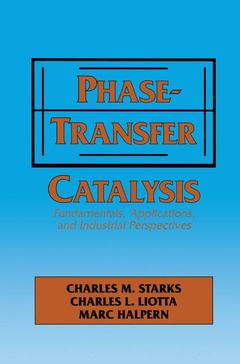Phase-Transfer Catalysis, Softcover reprint of the original 1st ed. 1994 Fundamentals, Applications, and Industrial Perspectives
Langue : Anglais
Auteurs : Starks C.M., Halper M.

Since 1971 when useful working concepts for the technique of phase-transfer catalysis (PTC) were introduced, the understanding, development, and applica tions of this method for conducting organic reactions has expanded exponentially. PTC has brought vast new dimensions and options to chemists and chemical engineers. From its use in less than ten commercial processes in 1975, PTC use has increased so that in the early 1990s it is involved in more than 600 industrial applications to manufacture products valued at between 10 and 20 billion U.S. dollars. PTC is widely used for simple organic reactions, steps in synthesis of pharmaceuticals, agricultural chemicals, perfumes, ftavorants, and dyes; for specialty polymerization reactions, polymer modifications, and monomer synthe sis; for pollution and environmental control processes; for analysis oftrace organic and inorganic compounds; and for many other applications. Often, PTC offers the best (and sometimes only) practical technique to obtain certain products. The authors experience in teaching a short course on phase-transfer catalysis has shown to us that a newcomer to PTC can easily be frustrated and confused by the large amount of information available in the literature and in patents. The purpose of this book, therefore, was to bring this information together in a logical and user-friendly way, without sacrificing matters of scholarly and fundamental importance.
Preface. Part 1: Basic concepts in phase-transfer catalysis: Phase-transfer-catalyzed reactions; Basic steps of phase-transfer catalysis; The PTC reaction rate matrix; Anion transfer and anion activation; Effect of reaction variables on transfer and intrinsic rates; Outline of compounds used as phase-transfer catalysts. Part 2: Phase-transfer catalysts -- Fundamentals I: Introduction; Structural factors affecting the distribution of anions between aqueous and organic phases; Structural factors affecting the distribution of phase-transfer catalyst cations between the aqueous and organic phases; Effects of the organic phase polarity on the distribution of phase-transfer cation-anion pairs; Effects of changes in organic phase polarity during reaction; Factors affecting the distribution of phase-transfer catalyst cation-anion pairs between an organic phase and an aqueous phase containing hydroxide ion; Effect of hydration of the transferred anion and the effect of inorganic salt and/or hydroxide concentration in the aqueous phase. Part 3: Phase-transfer catalysis -- Fundamentals II: Introduction; Liquid-liquid PTC; Solid-liquid PTC. Part 4: Phase-transfer catalysts: Introduction; Use of quaternary salts as phase-transfer catalysts; Macrocyclic and macrobicyclic ligands; PEGs, Tris (3, 6-dioxahepty)amine (TDA-1), and related ethoxylated compounds as phase-transfer catalysts; Other soluable polymers and related multifunctional compounds as phase-transfer catalysts; Use of dual PTC catalysts or use of cocatalysts in phase-transfer systems; Catalysts for transfer of species other than anions; Separation and recovery of phase-transfer catalysts. Part 5: Insoluable phase-transfer catalysts: Introduction; PTC catalysts bound to insoluable resins; Phase-transfer catalysts bound to inorganic solid supports; PTC catalysts contained in a separate liquid phase (Third-liquid-phase catalyst). Part 6: Variables in reaction design for laboratory and industrial applications of phase-transfer catalysis: Choice of catalyst; Choice of solvent; Presence of water; Agitation; Choice of anion, leaving group, and counteranion; Choice of base; Guidelines for exploring new PTC applications. Part 7: Phase-transfer catalysis displacement reactions with simple anions: General considerations; Behavior of various anions in PTC displacement reactions. Part 8: Phase-transfer catalysis reaction with strong bases: C-Alkylation; N-Alkylation; O-Alkylation -- Etherification; S-Alikylation -- Thioetherification; Dehydrohalogenation; Carbene reactions; Condensation reactions; Deuterium exchange, isomerization, and oxidation. Part 9: Phase-transfer catalysis -- Polymerization and polymer modification: Introduction; Polymer synthesis; Chemical modification of polymers. Part 10: Phase-transfer-catalyzed oxidations: Introduction; Permanganate oxidations; Oxidations with hyperchlorite and hypobromite; PTC oxidations with hydrogen peroxide; PTC air or oxygen oxidations; Oxidations by persulfates; PTC oxidations with nitric acid; PTC carbon tetrachloride/sodium hydroxide oxidations; PTC oxidations with perborate; PTC oxidations with ferrate and ferricyanide; PTC oxidations with superoxide; PTC electrochemical oxidations; PTC oxidations with other oxidents. Part 11: Phase-transfer-catalyzed reductions: Sodium borohydride reductions; Lithium aluminum hydride reductions; Reductions with sodium formate; Reductions with sulfur-containing anions; Hydrogenation; Reductions with formaldehyde; Electrochemical reduction; Photochemical reduction; Wolff-Kishner reduction; Reduction by dodecarbonyltriiron and related species. Part 12: Phase-transfer catalysis -- Chiral phase-transfer catalyzed formation of carbon-carbon bonds: Introduction; Alkylation reactions. Part 13: Phase-transfer catalysis - Transition metal cocatalyzed reactions: Introduction; Carbonylation and reactions with carbon monoxide; PTC reduction and hydrogenation
The three authors have produced a nicely intergrated piece of work and the quality of presentation, including structures,equations, figures and graphs, is excellent...This particular textbook is likely to prove a major landmark...From time to time a textbook appears of a quality destined to make its value long-lived. This is one such example. The authors are to be congratulated on what they have achieved - Reactive Polymers, The three authors have produced a nicely intergrated piece of work and the quality of presentation, including structures,equations, figures and graphs, is excellent...This particular textbook is likely to prove a major landmark...From time to time a textbook appears of a quality destined to make its value long-lived. This is one such example. The authors are to be congratulated on what they have achieved - Reactive Polymers, The three authors have produced a nicely intergrated piece of work and the quality of presentation, including structures,equations, figures and graphs, is excellent...This particular textbook is likely to prove a major landmark...From time to time a textbook appears of a quality destined to make its value long-lived. This is one such example. The authors are to be congratulated on what they have achieved - Reactive Polymers
Date de parution : 10-2013
Ouvrage de 668 p.
15.5x23.5 cm
Disponible chez l'éditeur (délai d'approvisionnement : 15 jours).
Prix indicatif 210,99 €
Ajouter au panierThèmes de Phase-Transfer Catalysis :
© 2024 LAVOISIER S.A.S.
